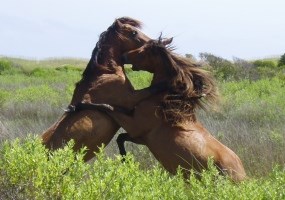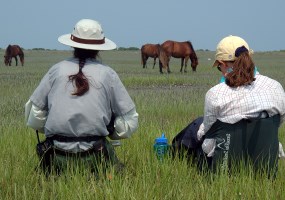
Cape Lookout National Seashore Since the herd is allowed to roam on an uninhabited island, human contact is limited. The horses are permitted to interact as wild animals. This provides the interested visitor the opportunity to learn about horse behaviors. Each dominant stallion (mature breeding male) gathers a harem of mares (mature breeding females). These harems may also include the younger offspring of the mares. 
Cape Lookout National Seashore Each harem has a highly evolved hierarchy in which there is always a dominant stallion called the Alpha Stallion. Sometimes there may be a younger, less dominant stallion called a Beta Stallion who assists the Alpha. These stallions are in charge and spend a lot of time and energy guarding their harem. If another stallion comes too close or attempts to steal a mare, the stallions will aggressively fight for their mares. Their fighting can involve anything from eye contact to kicking and biting. This display of aggression can also be used within the harem to show dominance, even amongst the mares. There is usually a dominant mare that gets her choice of grass and is the first to drink. Youngsters are generally lower in the hierarchy than the adults and are usually kicked out as they mature. As soon as females mature, they get picked up by another herd. The young males will often form "Bachelor" herds, using this time to grow stronger and learn to fight. When they are strong enough they will steal some mares and start their own harems. 
Cape Lookout National Seashore Horse Watching Tips Horse watching has become a popular activity at Cape Lookout National Seashore. It does not require much equipment other than binoculars, water, and hiking shoes. It can be done year round but it is more common in the summer. Unfortunately, summer brings out the bugs, so be sure to bring bug repellent as well as sun screen. The horses can be anywhere on the island and it is not always easy to find them, but with some patience they can be found. Once a horse is seen, it is best to observe them from a distance. Like any wild animal, they usually move away if you get too close. They will also bite and kick if they feel threatened. Being able to observe their natural behavior is the goal in preserving these horses. Getting a chance to see them herding, grooming, digging for fresh water in one of the water springs, or fighting for dominance is a glimpse into their life that can be a memorable experience. REMEMBER: horses can move amazingly fast: for your own safety and for theirs, the horses should not be approached or fed. |
Last updated: December 21, 2017
